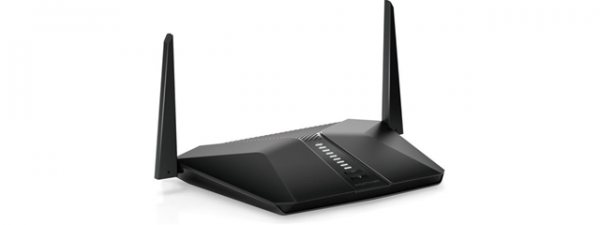
ASUS RT-AX68U is the spiritual successor of a very popular wireless router: ASUS RT-AC68U. The new model has an elegant look, offering support for Wi-Fi 6, excellent security features, and an innovative VPN app for your mobile devices. If you want to know what you get when buying the ASUS RT-AX68U AX2700 dual-band Wi-Fi 6 router and how it works in the real world, read this review:
ASUS RT-AX68U: Who is it good for?
This wireless router is a suitable choice for:
- People who want support for Wi-Fi 6
- Users with less modern devices who also want good performance when using older standards in their network (Wi-Fi 4 and Wi-Fi 5)
- Parents who desire efficient parental controls for their home network
- Users who want a secure network with proper antivirus and firewall protection
- People who want to remotely control their router from anywhere on the internet using a mobile app
- Users who want to control their home network using Alexa and IFTTT (If This, Then That)
Pros and cons
Here are the things we like about ASUS RT-AX68U:
- Wi-Fi 6 support that works well
- Good-looking design that is going to please many users
- Excellent performance when using Wi-Fi 5 and Wi-Fi 4
- Two USB ports: USB 2.0 and a very fast USB 3.0 port
- Excellent security tools and parental controls
- You can remotely control it with a mobile app from anywhere on the internet
- Innovative VPN app that connects your mobile devices to your home network
- Generous multilingual support and easily accessible Help documentation
There are a few downsides too:
- It doesn’t have 160MHz channel width support
- It cannot be mounted on walls

Verdict
ASUS RT-AX68U is one of our favorite wireless routers with Wi-Fi 6 for several reasons: we like the way it looks, and we appreciate how it performs when using older standards like Wi-Fi 4 and Wi-Fi 5. Plenty of households and small businesses don’t have many modern devices and computers that work well with Wi-Fi 6. Most Wi-Fi 6 routers focus on providing the best performance when using the new standard, while ASUS RT-AX68U also delivers excellent performance when using the older standards. To top things off, the new Instant Guard mobile app allows you to connect to your home through VPN and protect your mobile devices while on the go. If you want a well-rounded Wi-Fi 6 router, ASUS RT-AX68U is an excellent choice that we recommend to everyone.
Unboxing the ASUS RT-AX68U AX2700 dual-band Wi-Fi 6 router
ASUS RT-AX68U comes in a black cardboard box with a picture of the device on the top. The packaging is similar to that of other ASUS Wi-Fi 6 routers, and it is easy to open. You find plenty of information about this model’s hardware and software specifications on all sides of the box.
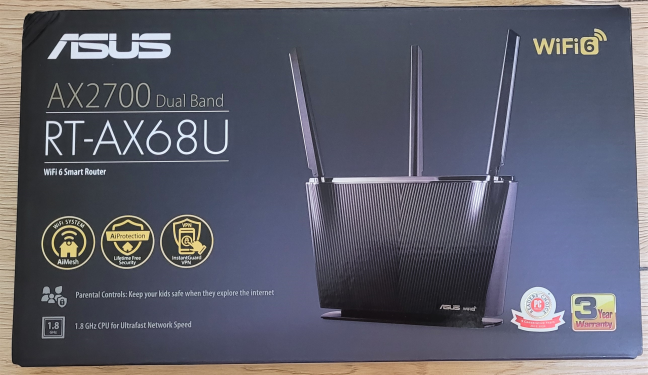
The packaging used for ASUS RT-AX68U
After unpacking everything, you find the following items inside the box: the router itself, its power adapter, a CAT5e network cable, the warranty, the quick start guide, and a leaflet with information about Wi-Fi 6. The brochure tells you about the possible compatibility issues between the Wi-Fi 6 standard and older devices that might not detect networks broadcast using this standard.
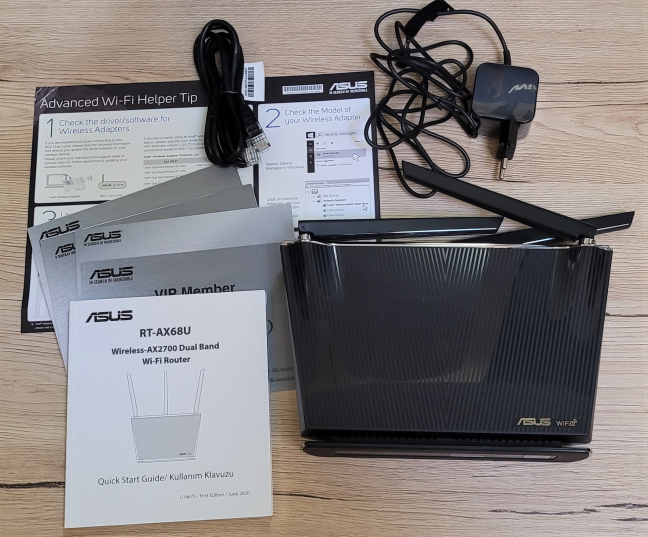
Unboxing the ASUS RT-AX68U
ASUS RT-AX68U offers a quick and pleasant unboxing experience. As you would expect, inside the box, you have everything you need to get started and set up your network.
Hardware specifications and design
RT-AX68U follows the design lines of one of ASUS’ most popular models: the venerable RT-AC68U, which is one of the company’s bestsellers. However, ASUS RT-AX68U is a lot thinner, weighs less, and has an updated design that's more modern and elegant than that of its predecessor. ASUS RT-AX68U has three nondetachable external antennas, and it provides support for Wi-Fi 6, WPA3 encryption, and 3x3 MU-MIMO wireless transmissions.
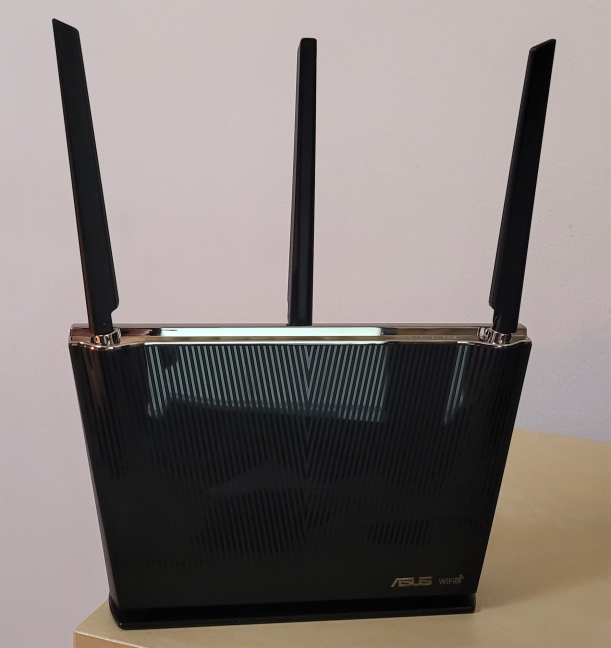
ASUS RT-AX68U has three non-detachable antennas
As you can see, the router is made of light plastic materials. The dominant color is black, and the router fits quite well in an elegant living room. The top margin is silver, and it includes a few discrete LEDs that signal the functioning status of the router and the Wi-Fi. They are tiny and nicely integrated into the top margin, so that they don’t bother users, not even during the night.
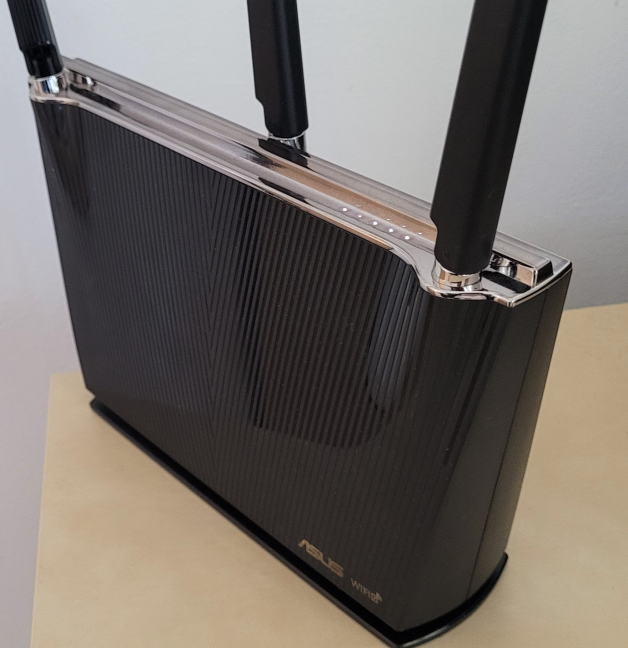
The LEDs on ASUS RT-AX68U are very discreet
This router doesn't have any holes for mounting it on walls, and on the bottom, there are rubber feet that hold it in place on flat surfaces and stickers with information about your specific device.
ASUS RT-AX68U has a size of 10.19 x 2.66 x 7.33 inches or 25.8 x 6.75 x 18.6 cm, and it weighs 1.38 lbs or about 625 grams. On the back, you find the ports available on the router: the WAN port and four Ethernet ports, all working at 1 Gbps, one USB 2.0 port, and one USB 3.0 port. There’s also the Power jack, the WPS and Reset buttons, as well as the button for turning the router on and off.
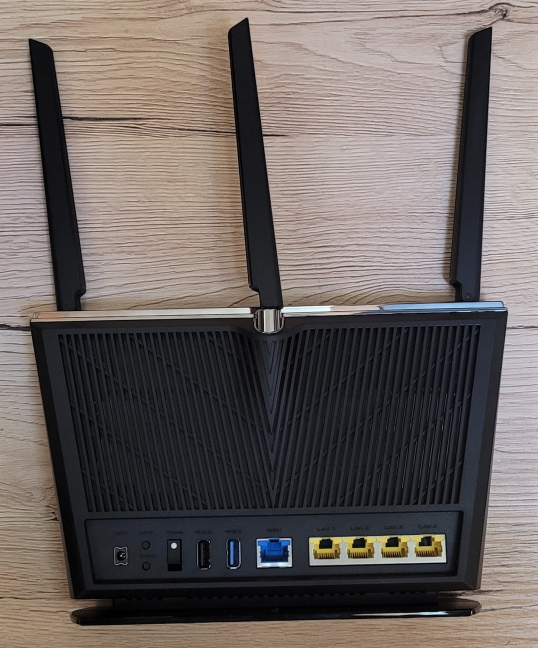
The ports on the back of the ASUS RT-AX68U
ASUS RT-AX68U is powered by a dual-core Broadcom BCM4906 processor, running at 1.8 GHz, 512 MB of RAM, and 256 MB of storage for the firmware. It is a dual-band router, with a maximum theoretical bandwidth split as follows: 861 Mbps on the 2.4 GHz band, and 1802 Mbps when using the 5 GHz band, while both are using the Wi-Fi 6 standard.
If you would like to learn more about this wireless router’s technical specifications, visit this page: ASUS RT-AX68U Specifications.
Setting up and using the ASUS RT-AX68U router
The setup process for the ASUS RT-AX68U router can be done both in a web browser and with the ASUS Router mobile app. The process involves detecting the type of internet connection that you use, providing the necessary connection details, choosing a name and password for the Wi-Fi, and deciding whether to enable Wi-Fi 6 or not.
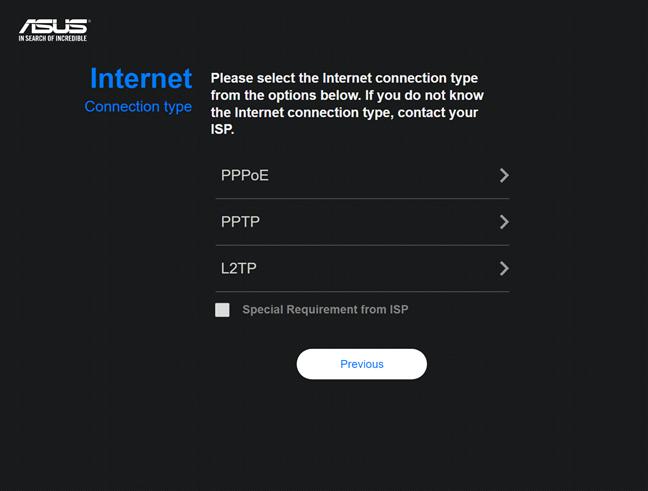
Setting up the internet connection on ASUS RT-AX68U
When turning on Wi-Fi 6, ASUS informs you that some wireless network cards may have connectivity issues with this standard. Before enabling it, it is a good idea to update the network drivers on all your laptops, computers, and devices.
NOTE: If you have a Sony PS5 console, and you want to know how well it works with Wi-Fi 6 networks, read: Sony PS5 & Wi-Fi 6: How does it work with an ASUS router for gaming?
When the quick setup is finished, connect your devices to the network and access the firmware for more fine-tuning. This router’s administration interface is easy to use, well organized into logical sections, and available in 25 languages. You control everything you wish, and both casual and advanced users will be happy with the level of detail they receive.
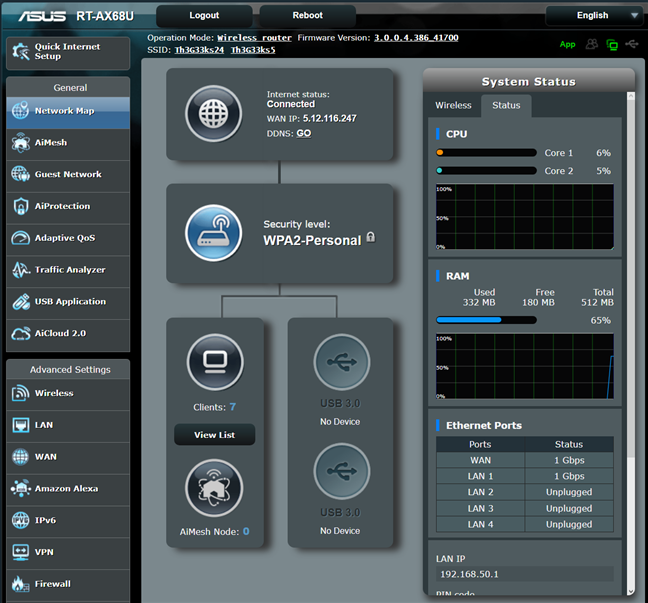
The firmware on the ASUS RT-AX68U
The help documentation is easily accessible: when you move the mouse cursor over a setting that you do not understand, a question mark is shown. Click the question mark, and you see information explaining that setting. Unfortunately, the documentation has not been updated to include information about all the latest firmware features, so this trick does not work for everything. However, it works often enough to be useful.
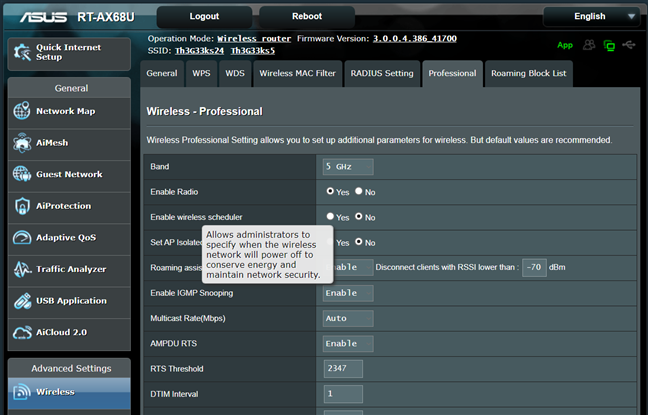
See more info about a setting on ASUS RT-AX68U
You can also set up and manage the router from any Android smartphone or iPhone using the ASUS Router app. The app can be used from anywhere on the internet, and it includes plenty of settings that can be configured.
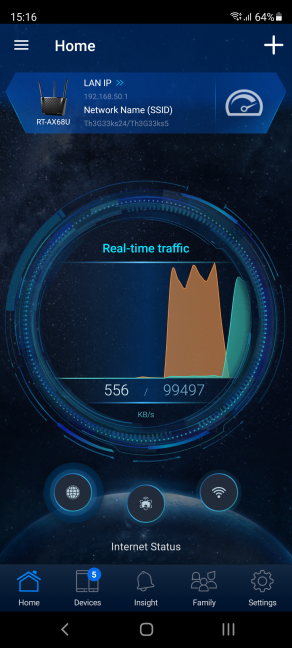
The ASUS Router app works with ASUS RT-AX68U
To make this router even more appealing, ASUS RT-AX68U, alongside other Wi-Fi 6 models, offers support for Instant Guard - a new mobile app created by ASUS that allows you to connect to your home network through VPN from a public Wi-Fi. This way, you can benefit from an encrypted connection that is not easily snooped by others and from the AiProtection module bundled with ASUS RT-AX68U.

The Instant Guard app works with ASUS RT-AX68U
To verify the quality of the Wi-Fi broadcast by ASUS RT-AX68U, we took our laptop and moved it to a room that is separated by one wall from the router. We made a wireless transfer on it, using a specialized app that measured the average speed and the network transfer variability. On the 2.4 GHz band and the Wi-Fi 4 standard, the average speed was higher than that of other Wi-Fi 6 routers we tested in recent months. However, the variability of the wireless transfer was relatively high.
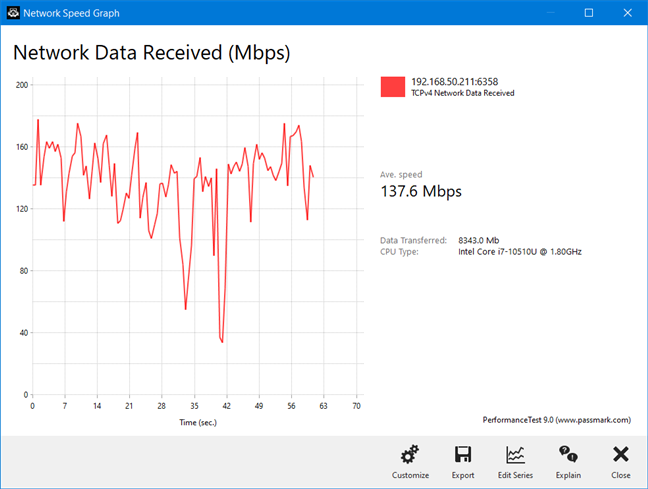
ASUS RT-AX68U - Wireless transfer on Wi-Fi 4
We switched to the 5 GHz band and the Wi-Fi 5 standard, and we were super pleased both with the average download speed that we measured and how stable the transfer was.
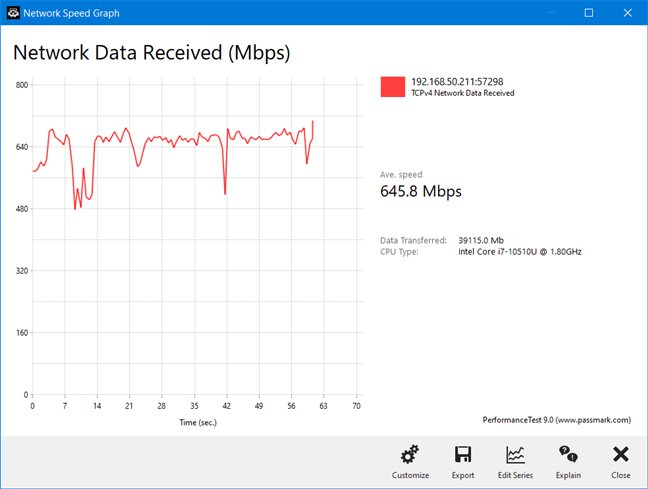
ASUS RT-AX68U - Wireless transfer on Wi-Fi 5
We switched to Wi-Fi 6 on the 5 GHz band, and the wireless data transfer was even stabler than on Wi-Fi 5, but the average speed was slightly lower.
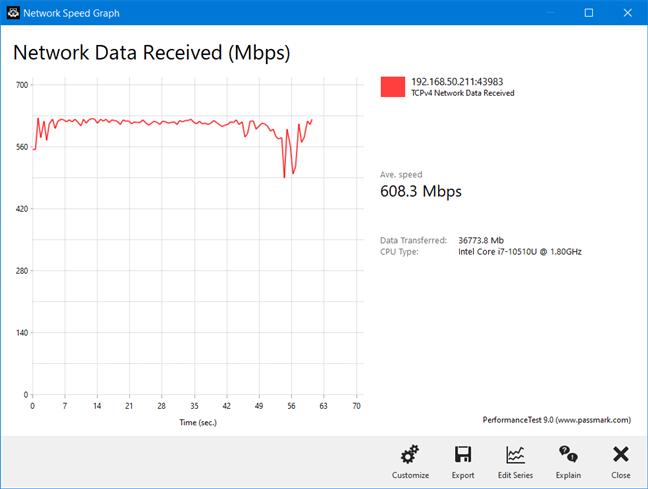
ASUS RT-AX68U - Wireless transfer on Wi-Fi 6
We were satisfied with how ASUS RT-AX68U worked in our testing, especially when using the older standards: Wi-Fi 4 and Wi-Fi 5. If you have many older devices that don’t yet work well with Wi-Fi 6, you may prefer this router because of its reliable performance when using the older standards.
If you want to know more about the real-world performance offered by ASUS RT-AX68U, including comparisons with other wireless routers, go to the next page of this review.


 05.03.2021
05.03.2021 


